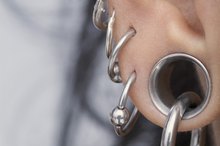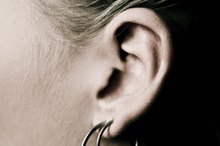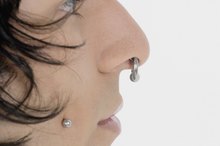Ear Gauge Infections
Stretching earlobes dates back as far as King Tutankhamen from Egypt, according to the information website Brimstone Organics. Modifying the size of earlobes portrays a different meaning to each wearer. Religious journeys, rites of passage, social caste placement and beauty are interpretations associated with stretched ears. The process of stretching ears consists of waiting periods after each size, or gauge, of stretching material is inserted, and attention to cleaning the earlobe and jewelry.
If you are experiencing serious medical symptoms, seek emergency treatment immediately.
Types
An infection occurs in a stretched ear piercing--incorrectly and commonly called "ear gauges"--when inappropriate jewelry is worn in the stretched piercing. Other causes of an infected stretched ear piercing might include bacteria from piercing tools or needles, foreign objects attached to jewelry for stretching reasons and blowouts--from stretching too quickly--that become infected from improper care.
Material Allergies
Why Do My Pierced Ears Smell?
Learn More
Wearing jewelry in a stretched ear piercing that is manufactured by a company that does not specialize in body jewelry can cause allergic reactions. Professional body jewelry suppliers are aware that the jewelry is inserted into fresh and healed piercings and provide materials that are less likely to provoke an allergic reaction. Stainless steel, titanium and niobium lessen the chance of experiencing an allergic reaction.
Discounted and cheap jewelry from manufacturers outside of the body piercing industry sell coated jewelry, which is marketed as titanium or niobium. True titanium and niobium achieve color by an electrical process. Coated jewelry contains a high level of nickel content and the coating flakes off into the stretched ear piercing after continuous wear and cleaning, causing irritation to the piercing. An allergic reaction is identified by an itchy rash, or by the piercing hole growing in size as if the hole is attempting to swallow the jewelry.
- Wearing jewelry in a stretched ear piercing that is manufactured by a company that does not specialize in body jewelry can cause allergic reactions.
Bacterial Infection
Bacterial infections in a stretched ear piercing can occur when unsanitary tools are used to perform the stretching or when jewelry is used that harbors bacteria. When an inappropriate tool is used for stretching ears, such as an ink pen, tape or straw, a bacterial infection, such as staphylococci, can occur. Taper pins sterilized in an autoclave are the safest tools to use to avoid a bacterial infection. Attaching tape and straw to jewelry to stretch the ears can result in rips, tears or fusion of the ear tissue to the tape or straw.
Sharing jewelry with others and inserting jewelry that is not sanitary or sterile into the ears can cause a bacterial infection, as can touching the stretched ears with the hands. Washing the ears daily and avoiding contact with hands greatly reduces the chance of contracting an infection in the earlobe piercing. Characteristics of a bacterial infection may include extreme swelling, fluids with a unpleasant odor or red streaks coming from the earlobe piercing.
- Bacterial infections in a stretched ear piercing can occur when unsanitary tools are used to perform the stretching or when jewelry is used that harbors bacteria.
- Sharing jewelry with others and inserting jewelry that is not sanitary or sterile into the ears can cause a bacterial infection, as can touching the stretched ears with the hands.
Misconceptions
How to Prevent Infection in Pierced Ears
Learn More
A misconception about stretched ear piercings is that an infection cannot develop if the ear piercing is healed. Dirty hands and saliva can cause an infection to develop in any ear piercing. Taking jewelry out during an infection is an unsafe practice. Taking jewelry out while an infection is healing is dangerous and can cause the piercing opening to close and trap the infection inside. Once the infection cannot drain, an abscess may develop. Wearing loose jewelry with a large diameter or length will allow the infection to drain properly and cease.
- A misconception about stretched ear piercings is that an infection cannot develop if the ear piercing is healed.
- Wearing loose jewelry with a large diameter or length will allow the infection to drain properly and cease.
Prevention/Solution
Following a professional piercer’s advice for daily care of stretched earlobes and jewelry can prevent the onset of an infection. Purchasing earrings only from a professional piercing shop should ensure that an allergic reaction will not occur. A professional should only perform a stretching or tapering procedure with sterile instruments. Keeping hands away from the stretched ear piercings and only touching the piercings while cleaning them--when the hands are laden with soap--will prevent unnecessary bacteria from entering the piercing. Changing a pillowcase frequently and sanitizing earphones, headsets and cell phones will help to prevent bacterial contamination.
- Following a professional piercer’s advice for daily care of stretched earlobes and jewelry can prevent the onset of an infection.
Related Articles
References
Resources
Writer Bio
Maude Coffey retired after 10 years working as a professional body modification artist in the tattoo industry. She is certified in principles of infection control and blood-borne pathogens. Coffey received additional training and classes, such as anatomy, jewelry standards and aftercare, from the Association of Professional Piercers. Coffey aims to educate about safe tattooing and piercing practices while writing for various websites.









